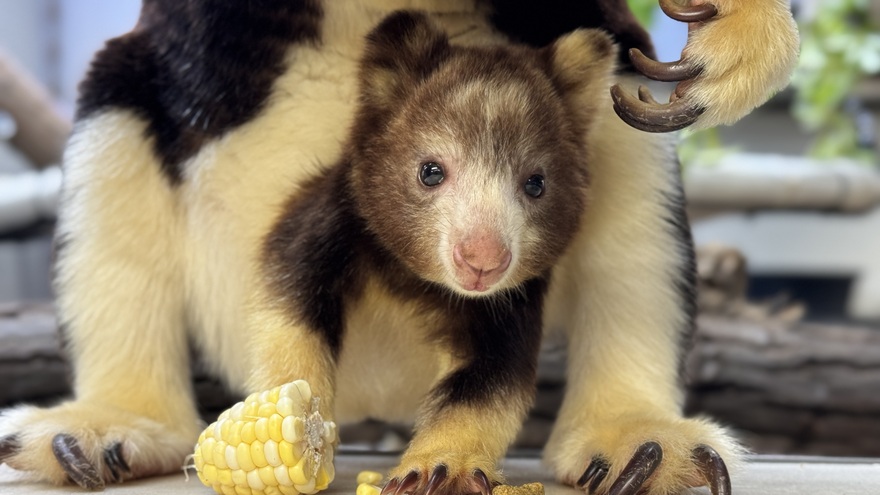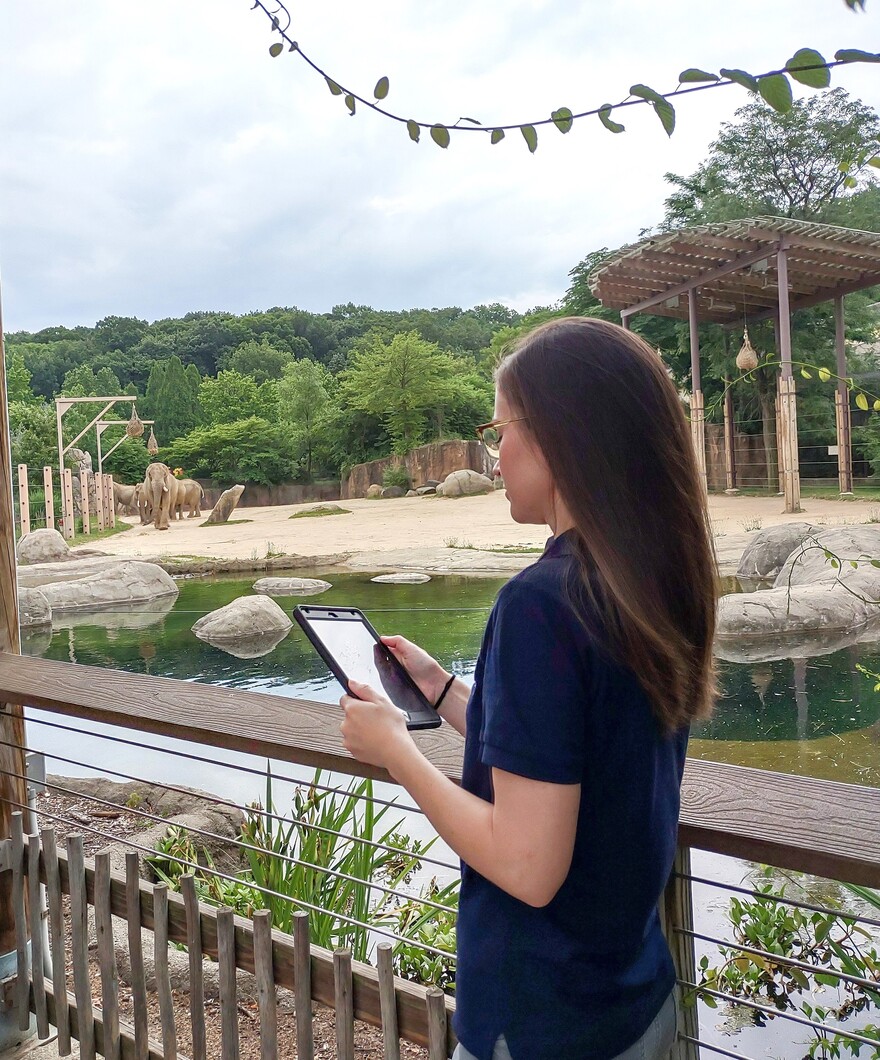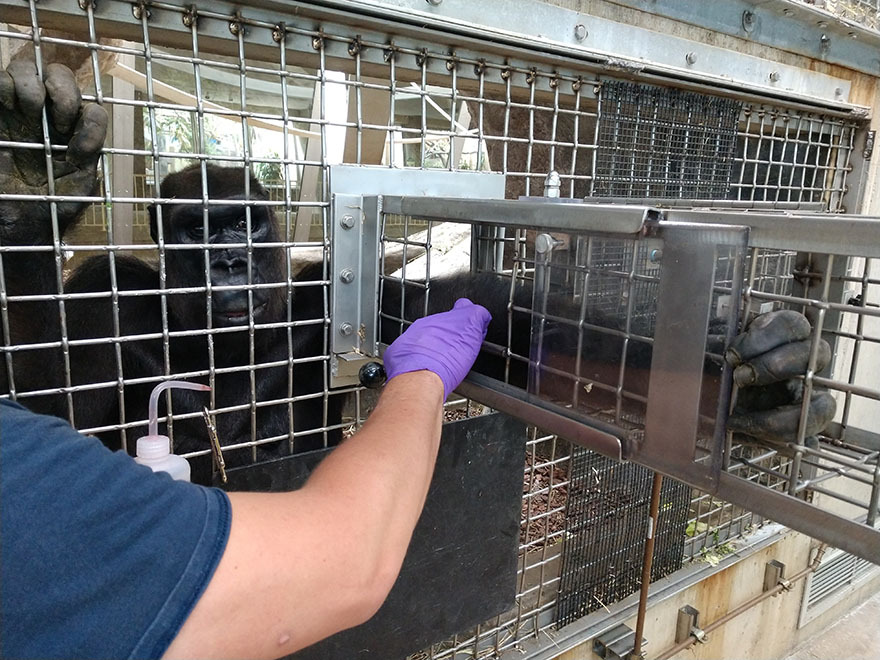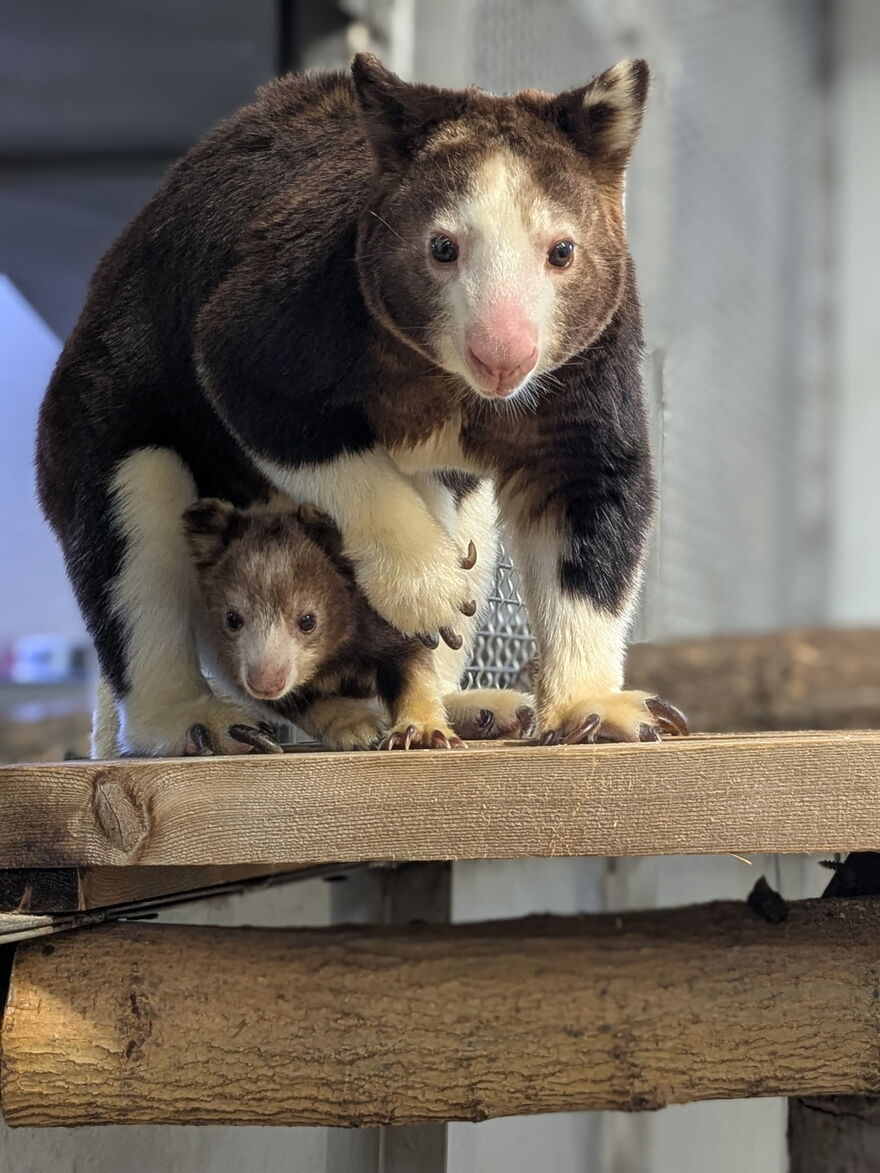How Zoo research drives better understanding and care for animals
The Matschie's tree kangaroo born at Cleveland Metroparks Zoo last September is the first of its species to be born in Cleveland since 1998 and a living representation of the Zoo's scientific expertise. Through dedicated research that informed diet and husbandry practices both here and across zoos, female tree kangaroo Modi was able to achieve conception and a successful pregnancy.

Tree kangaroo joey born on September 30, 2024.
The Zoo is a leader in research that investigates questions about animal health and behavior and drives greater understanding and care of many species. Its Conservation and Science team is relentlessly curious and persistent in research projects that require collaborative data collection and meticulous analysis over the course of months – and more often, years.
This commitment to research is rare among zoos – few prioritize the investment in highly trained scientists, laboratory facilities and equipment, and time spent by science, veterinary, and animal care staff alike to implement the work. It is a focus that sets Cleveland Metroparks Zoo apart. With five PhD-level scientists on staff and a laboratory equipped to process a range of biological samples, the Zoo is at the forefront, advancing the conversation about animal health and well-being in Association of Zoos and Aquariums (AZA)-accredited zoos.

The Science team (LtoR): Christopher Jackson, Dr. Diana Koester, Laura Amendolagine, Dr. Kaylin Tennant, Dr. Pam Dennis, Maura Plocek, Dr. Noah Dunham, and Dr. Kristen Lukas. Not pictured: Laura Angley.
The Zoo is also shepherding new scientists into the field through a unique partnership with Case Western Reserve University, bringing in graduate students to gain experience at the Zoo as they pursue their PhDs. “I am so proud of the Zoo's talented and dedicated team of researchers, the majority of whom are women, who are changing the lives of animals in zoos across the globe while training the next generation of zoo-based scientists,” said Director of Conservation and Science Dr. Kristen Lukas.
A PRACTICAL APPROACH
The seed of a new research project tends to arrive in the form of a question, and often in discussions among animal keepers, curators, veterinary staff, and the research team. “Sometimes we’re just listening and we’ll hear a question that we can help answer,” said Research Curator Dr. Diana Koester, “and sometimes we share it with other AZA zoos and learn that others have the same question about that species.” A question develops into a research proposal through buy-in among applicable Zoo staff and a Zoo scientist interested in spearheading it.

Director of Conservation and Science Dr. Kristen Lukas and Research Curator Dr. Diana Koester discussing a research project.
Research proposals undergo an internal review process that evaluates the core question, soundness of methodology, feasibility of data collection, and potential value of results. Koester explained, “We have a committee that consists of members of Conservation and Science, Animal Care, Veterinary Programs, and potentially other divisions like Education and Engagement, Guest Services, even Horticulture, depending on the scope of the project.” The committee assesses not only scientific merit but also the impact on the animals. Koester affirmed that the animals’ well-being is always priority, and a proposal may be rejected if it has the potential to cause undue stress or negative interactions with the animals. “With some types of data collection we have to ask, is this feasible – can we accommodate this? And should we accommodate this?”
The Zoo also works collaboratively with other AZA zoos on research projects, asking them to participate in studies spearheaded here in Cleveland and participating in the research efforts of other zoos. Many zoo scientists have similar observations and questions about the animals in their care, and working together to examine them helps answer those questions and improve husbandry practices across the board. Small sample sizes are a central challenge to the work, so collecting from more individuals also strengthens the quality of the data.

Dr. Kaylin Tennent collecting behavioral data at African Elephant Crossing.
The driving philosophy behind the Zoo’s research program – and the compass by which it decides what questions to pursue – is improving animal health and care standards. “It’s not science for science’s sake,” said Koester. Research Curator Noah Dunham continued, “Yeah, that’s an important distinction to make – that it’s applied research, always geared towards improving animal well-being.” Dunham said that this pursuit often involves looking at the whole picture, investigating everything from animal behavior to physiology to environmental factors like light, temperature, and sound.
DIGGING INTO DATA
Zoo scientists work with veterinary staff, animal keepers, graduate students, and volunteers to collect data according to the parameters of the study, which may employ observational data, biological samples, or a combination of both. The voluntary positive reinforcement training that many animals participate in is a key piece of the puzzle here, allowing veterinary and animal care staff to collect biomaterial samples including blood, urine, saliva, and feces for analysis.
The goal of keeping collection low-stress for the animals always guides decisions on whether and how to move forward; the team asks, ‘Can we? Should we?’ and collaborates with the keepers in charge of conducting any training needed for collection. Oftentimes, Koester said, keepers and animals alike are eager for a new training challenge to work on together to enrich their relationship. Dunham added, “If we can figure out a way to support data collection for our project that is completely non-invasive, that's what we default to.” Sometimes it is as easy as scooping up a fecal sample from the animal’s habitat.

Gorillas participate in voluntary blood draws for data collection.
Behavioral data gleaned through observation may be done live or by reviewing camera footage. Zoo visitors might notice someone working with a tablet near an animal habitat – this person is collecting data! Using a program called ZooMonitor, which was developed at Lincoln Park Zoo by a former Cleveland Metroparks Zoo graduate student, the observer may record what the animal is doing or what area of the habitat they’re occupying at regularly timed intervals prompted by a beep. They may also record all occurrences of a specific behavior within a certain time period. “This is a tried-and-true method of behavioral data collection that gives us an idea of how the animals are spending their time,” Koester explained.
Back in the Sarah Allison Steffee Center for Zoological Medicine, data is processed and analyzed both at the computer desk and the lab bench. Cleveland Metroparks Zoo is one of just several zoos in the country with the capabilities to process its own biological samples, analyzing a range of blood values, hormones, nutrient levels, and other health indicators and even extracting microbial DNA. Having a robust laboratory on-site does not just allow for more efficient and cost-effective processing, it empowers the Zoo to conduct higher-level research - and more of it, making the Zoo a leader among AZA zoos in advancing scientific understanding and care of animals.

Graduate Research Assistant Christopher Jackson processing biological samples in the lab.
WORKING TOGETHER
With data processed and analyzed for statistical significance, the lead researcher on a project pulls together their findings and shares them first with the internal team directly involved with the project. From there, depending on the nature of the project, they may discuss husbandry changes to environment, diet, schedule, and more. Change is not always easy, but the strong rapport and communication between the Science and Animal Care staff is a strong foundation for those conversations. Koester said, “It’s a testament to the relationships we’ve built with one another, because it can be a tricky thing. We’re scientists – we're not the ones working with the animals every day. So when we make recommendations about adjusting their care, the way we do that matters.”

Laura Amendolagine using the freeze dryer to extract liquid from fecal samples.
This strong relationship reflects the Animal Care team’s commitment to providing exemplary, science-driven care – and the Zoo’s focus on applied science that can be implemented to continuously improve practices. “No longer are there lines between research staff and animal care staff,” Dr. Lukas said, “We are all working together to advance the science of animal care so we can continuously improve the care, health, and well-being of wildlife populations.”
The research is also shared and reviewed more broadly with colleagues at other AZA zoos in meetings and at conferences and may lead to updates to the animal care manual for the species maintained by its Species Survival Plan (SSP), which works across AZA zoos to maintain a healthy, genetically diverse population of animals in human care. The Zoo’s research has spurred changes to care practices for a diverse range of species including gorillas, tree kangaroos, cheetahs, giant anteaters, black rhinos, Allen’s swamp monkeys, red-rumped agoutis, Francois langurs, aye-ayes, slow loris, pottos, and prehensile-tailed porcupines.

The Science and Animal Care teams have worked together to make evidence-driven adjustments to care practices for a variety of species, including a modified cheetah diet that more closely mimics how they eat in the wild.
CELEBRATING SUCCESSES
When female Matschie’s tree kangaroo Sausi arrived at Cleveland Metroparks Zoo in 2017, the Animal Care team noted that she was overweight and not cycling normally. The tree kangaroo SSP recommended hormone monitoring to better understand Sausi’s issues and explore population-wide reproduction issues.
Dr. Koester, who serves as the Tree Kangaroo SSP Research/Endocrine Advisor, implemented the hormone monitoring initiative, finding a dearth of hormonal data for the tree kangaroo population. What began at Cleveland Metroparks Zoo grew into an SSP-wide effort to investigate diet in conjunction with hormones, looking at energy expenditure, standard calorie recommendations and macronutrient content.
The diet aspect of the study utilized first-of-its-kind data for tree kangaroos, gathered through teamwork between SSP zoos’ animal care and science teams. The Cleveland team trained the tree kangaroos for voluntary blood draws to make data collection easier and less stressful for both animals and staff; this was the first instance of this training in tree kangaroos. Other zoos have since implemented the training. In addition to zoo data, the SSP partnered with the Tree Kangaroo Conservation Program to include data from wild tree kangaroos for comparison. SSP nutritionist Dr. Ellen Dierenfeld led the analysis of diet data and the team used its learnings to create new recommendations, which were rolled out across SSP zoos in early 2023 and have since been implemented successfully at multiple institutions.

Tree kangaroo Modi, with joey.
The SSP has seen positive health outcomes across the population: healthy weights, better skin and fur, improved joint health, and higher rates of reproductive success. Here in Cleveland, Sausi achieved a healthy weight and began cycling normally as a result of the changes to her care. On the heels of this success, Modi arrived. A female tree kangaroo that was recommended as a breeding partner for male tree kangaroo Kiari, Modi represented an opportunity to employ the new diet program with a younger individual and see if it would lead to a joey.
Lo and behold, it did. The Science and Animal Care teams were delighted to find that after the tree kangaroos' introduction and first breeding attempt, they produced a joey, which was born on September 30, 2024. He is growing beautifully and beginning to explore the world outside his mother's pouch, but will still visit it to nurse until up to 18 months after birth. Animal Keeper Allyson Price shared that new mom Modi is a natural. “Modi has been an amazing and attentive mom. As he starts coming out of the pouch, she’s making sure she’s close by if he needs her. She’s also starting to share her food with him, which is great,” she said. Modi tends to be reserved, so the pair may be visible in their Australian Adventure habitat at times, but the keepers are respecting her choice to hang out behind the scenes whenever she wishes.
Koester reflected on the significance of Modi’s successful pregnancy and healthy joey:
“Knowing our work is making a difference for the entire tree kangaroo population in zoos is certainly wonderful, but seeing first-hand a new joey resulting from everything we have worked so hard for is exhilarating. I’m so happy the team here can experience the fruits of their efforts and watch this little one grow up happy and healthy.”
INVESTING IN THE FUTURE
The Zoo’s Science team boasts a deep roster and an impressive range of expertise. These scientists are pushing forward consequential research – and simultaneously building the ladder for the next generation of professionals in their field. Through its partnership with Case Western Reserve University (CWRU), the Zoo brings in PhD candidates to work part-time as they pursue their degree. It’s a rare opportunity; very few other programs integrate graduate students as employees, affording them real experience in a zoo environment to see how it functions, how the various departments work together, and how research happens in this unique environment. “It is an absolutely incredible program,” Graduate Research Assistant Christopher Jackson said. “Not only am I being supported in the research that fascinates me, but I also get real experience working at an AZA-accredited zoological institution. Never in a million years could I have imagined a program like this one where I get the opportunity to research the topics I love in a zoo setting.”

Research Curator Dr. Noah Dunham (left) and Graduate Research Assistant Maura Plocek showing samples of extracted DNA.
This partnership benefits the Zoo too, attracting fresh talent and diverse interests to strengthen its research efforts. More broadly, the program is producing top-tier scientists to enter the field upon graduation, equipped with real-life work experience in a zoo. “We are shaping not just the scientists that come through the program, but also what zoo scientists look like moving forward – it's really awesome,” Koester said. Lukas continued, “Collaborative partnerships like ours with Case Western Reserve University are key to making sure we have the best and brightest people working to address the challenges facing wildlife conservation, animal well-being, and population sustainability.” Graduates of CWRU that completed the Zoo research program have gone on to secure competitive positions in science, animal care and well-being, and wildlife conservation at AZA zoos across the country.
Research is something that sets Cleveland Metroparks Zoo apart. Its dedication of resources, commitment to teamwork among departments, and tenacity in navigating the challenges of conducting science in a zoo setting have put it at the cutting edge of its field. The team’s curiosity only grows as it gains new insights into animal health and well-being, answers spawning new questions to investigate. At the center of it all, the application of sound science continues to redefine world-class care and ensure thriving animal populations at Cleveland Metroparks Zoo and around the world.


